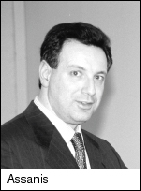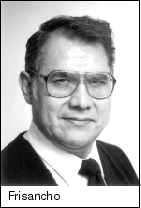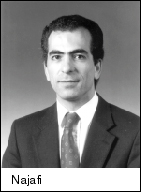The University Record, March 8, 1999
7 named Arthur F. Thurnau Professors
By Wono Lee
News and Information Services
Seven faculty members have been named to the Arthur F. Thurnau Professorship, which “recognizes and rewards faculty for outstanding contributions to undergraduate education.”
Those honored are Julia Potter Adams, associate professor of sociology; Dionissios N. Assanis, professor of mechanical engineering and applied mechanics; Vincent E. Castagnacci, professor of art; Susan J. Douglas, the Catherine Neafie Kellogg Professor of Communication and professor of communication; A. Roberto Frisancho, professor of anthropology; Khalil Najafi, professor of electrical engineering and computer science, and professor of biomedical engineering; and Christopher M. Peterson, professor of psychology.
The Thurnau Professorships, named after Arthur F. Thurnau, a U-M student in 1902-04, are supported by the Thurnau Charitable Trust established through his will. Each year, the University selects faculty members who are designated as Thurnau Professors for a three-year term and receive a grant to support their teaching activities.
 Adams is “widely regarded as one of the best, if not the best, comparative historical sociologists for her generation,” said Provost Nancy Cantor. “The excellence of Prof. Adams’ teaching was recognized in 1993 when she received the Class of 1923 Memorial Award, given each year to one assistant professor in the College of Literature, Science, and the Arts ‘for excellence in undergraduate instruction and scholarly promise.’ While still an assistant professor, she was director of the Graduate Program in the Department of Sociology and, in that role, rejuvenated the program.”
Adams is “widely regarded as one of the best, if not the best, comparative historical sociologists for her generation,” said Provost Nancy Cantor. “The excellence of Prof. Adams’ teaching was recognized in 1993 when she received the Class of 1923 Memorial Award, given each year to one assistant professor in the College of Literature, Science, and the Arts ‘for excellence in undergraduate instruction and scholarly promise.’ While still an assistant professor, she was director of the Graduate Program in the Department of Sociology and, in that role, rejuvenated the program.”
 Assanis “has truly revitalized the department’s teaching and research efforts and has breathed new life into the W.E. Lay Automotive Laboratory. He is a tireless worker who has performed this task expeditiously and with a great deal of enthusiasm through the development of a modern undergraduate course in internal combustion engines. His innovative teaching style involves the parallel and well-coordinated use of lectures, laboratory experiments, movies and computer simulation to teach both theory and application.”
Assanis “has truly revitalized the department’s teaching and research efforts and has breathed new life into the W.E. Lay Automotive Laboratory. He is a tireless worker who has performed this task expeditiously and with a great deal of enthusiasm through the development of a modern undergraduate course in internal combustion engines. His innovative teaching style involves the parallel and well-coordinated use of lectures, laboratory experiments, movies and computer simulation to teach both theory and application.”
 Castagnacci is “an outstanding artist, scholar and educator who is held in the highest regard by his students and colleagues for both his rigorous, challenging and thoughtful teaching, and for his beautiful and engaging drawings and paintings. He demands excellence from himself and fosters it in his students, while continuously enriching the criteria he uses to calibrate this thinking and work. The nature of the studio classes Castagnacci teaches allows him to work directly with each student. It is a wonderfully effective way to teach and learn and is extraordinarily demanding of both teacher and student.”
Castagnacci is “an outstanding artist, scholar and educator who is held in the highest regard by his students and colleagues for both his rigorous, challenging and thoughtful teaching, and for his beautiful and engaging drawings and paintings. He demands excellence from himself and fosters it in his students, while continuously enriching the criteria he uses to calibrate this thinking and work. The nature of the studio classes Castagnacci teaches allows him to work directly with each student. It is a wonderfully effective way to teach and learn and is extraordinarily demanding of both teacher and student.”
 Douglas’ undergraduate teaching has been “nothing short of exceptional,” Cantor said. “Her evaluations have been among the very highest in the Department of Communication Studies. She has high energy, an effective lecturing style, an ability to alter students’ ways of thinking about the media, and a caring relationship with students. One key to Douglas’ success with undergraduates is her gift for helping them make new and interesting connections—connections between media studies and students’ everyday experiences, between what they see and hear on the media and the social, political and economic forces shaping contemporary America.”
Douglas’ undergraduate teaching has been “nothing short of exceptional,” Cantor said. “Her evaluations have been among the very highest in the Department of Communication Studies. She has high energy, an effective lecturing style, an ability to alter students’ ways of thinking about the media, and a caring relationship with students. One key to Douglas’ success with undergraduates is her gift for helping them make new and interesting connections—connections between media studies and students’ everyday experiences, between what they see and hear on the media and the social, political and economic forces shaping contemporary America.”
 Frisancho “has dedicated a great deal of time and effort to enhancing the undergraduate curriculum in biological anthropology, in addition to his work with graduate students and his research activities. He regularly teaches Introductory Biological Anthropology, where enrollment has more than doubled because of his enthusiastic, informed, and effective teaching. For several years, Frisancho has been a faculty mentor for the Training Program for Undergraduate Minorities in the Fogarty International Training Program, Center for Human Growth and Development. In that role, he has trained and prepared several undergraduate students for research experiences in Bolivia.”
Frisancho “has dedicated a great deal of time and effort to enhancing the undergraduate curriculum in biological anthropology, in addition to his work with graduate students and his research activities. He regularly teaches Introductory Biological Anthropology, where enrollment has more than doubled because of his enthusiastic, informed, and effective teaching. For several years, Frisancho has been a faculty mentor for the Training Program for Undergraduate Minorities in the Fogarty International Training Program, Center for Human Growth and Development. In that role, he has trained and prepared several undergraduate students for research experiences in Bolivia.”
 Najafi is “an example of the consummate teaching researcher,” Cantor said. His commitment to undergraduate education is evident from his consistently exceptional course evaluation scores; from glowing letters of support written by his present and former graduate students; from the repetition of such words as ‘excellent,’ ‘caring,’ ‘accessible,’ ‘enthusiastic’ and ‘knowledgeable’ on the open course evaluation forms; from his leadership role in redesigning the course in analog circuits in the College of Engineering; from his involvement in restructuring undergraduate core courses; and from the teaching awards he has received from engineering students, the Department of Electrical Engineering and Computer Science and the College of Engineering.”
Najafi is “an example of the consummate teaching researcher,” Cantor said. His commitment to undergraduate education is evident from his consistently exceptional course evaluation scores; from glowing letters of support written by his present and former graduate students; from the repetition of such words as ‘excellent,’ ‘caring,’ ‘accessible,’ ‘enthusiastic’ and ‘knowledgeable’ on the open course evaluation forms; from his leadership role in redesigning the course in analog circuits in the College of Engineering; from his involvement in restructuring undergraduate core courses; and from the teaching awards he has received from engineering students, the Department of Electrical Engineering and Computer Science and the College of Engineering.”
 Peterson is “an inspired, dedicated and wonderfully effective teacher. He accomplishes a rare blend of excitement in teaching coupled with a passion for the ideas, concepts, and research that he helps students encounter and master. He also publishes regularly with his undergraduate advisees. Since 1990, more than 20 of his undergraduate students have been co-authors on articles in psychology journals. He is a professor who is one of the best lecturers on campus, a first-class research teacher in informal settings, and a beloved mentor for literally scores of students. He has already received five major teaching awards in recognition of the quality of both his formal and informal teaching.”
Peterson is “an inspired, dedicated and wonderfully effective teacher. He accomplishes a rare blend of excitement in teaching coupled with a passion for the ideas, concepts, and research that he helps students encounter and master. He also publishes regularly with his undergraduate advisees. Since 1990, more than 20 of his undergraduate students have been co-authors on articles in psychology journals. He is a professor who is one of the best lecturers on campus, a first-class research teacher in informal settings, and a beloved mentor for literally scores of students. He has already received five major teaching awards in recognition of the quality of both his formal and informal teaching.”

